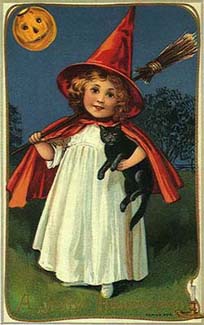![]()
![]() Booking and Appearances | The
Conclave | Convention Report
| The Family Album | Historical
Vault | Special Features |
The 13 List
Booking and Appearances | The
Conclave | Convention Report
| The Family Album | Historical
Vault | Special Features |
The 13 List
 A young relative of mine,
just over two and a half years old, has reached the stage in her
life where she can express an opinion about what she wants to
be for Halloween. Not that she wasn't a lovely fairy last year,
and an adorable baby Dorothy (from The Wizard of Oz) the
year before, but this year she has decided a costume on her own.
And she's going to be that most iconic of Halloween spirits--
the Witch.
A young relative of mine,
just over two and a half years old, has reached the stage in her
life where she can express an opinion about what she wants to
be for Halloween. Not that she wasn't a lovely fairy last year,
and an adorable baby Dorothy (from The Wizard of Oz) the
year before, but this year she has decided a costume on her own.
And she's going to be that most iconic of Halloween spirits--
the Witch.
Now I'm sure most of my readers are at least passing familiar with the history of witchcraft, at least in Europe and North America, how there really were people in ancient times who practiced a form of earth magic, and that in later centuries these people (or victims of the fear of them) were persecuted and even put to death.
But in discussing what exactly will be needed to transform this young mortal child into a dark sorceress, I began to wonder about the origins of the trappings we associate with a typical witch. Why does she carry a broom and wear a pointed hat? And what about that black cat?
As you may have guessed, these things all have real historical origins, either in the actual practice of ancient witchcraft, or in the strongly-held beliefs of medieval society. For starters, witches dressed entirely in black for very practical reasons. They had to practice their beliefs in secret, and black clothing allowed them to move about unseen in the dark. Modern witches also claim the color has protective qualities on a more metaphysical level, protecting the witch from evil spirits who might wish to do her harm.
The tall pointed hat is the most distinctive part of her wardrobe, so much so that the hat alone identifies her as a witch. Other types of magical people, such as wizards and some fairy-folk, also wear pointed hats, although these are generally in other colors besides black. A simple reason for this is that at one time pointed hats were the style among the elite, a style that the Puritans denounced. Their drawings of typical "witches" naturally included what they considered worldly and devil-inspired clothing, and this look survived. But again, modern practitioners have another explanation. The cone shape, they say, focuses the witch's mental energy, and helps her direct her spells.
The idea of witches flying on their broomsticks actually comes from transcripts and documents that survive from the historical witch trials. These "witches" were usually people known to the towns where they lived, people who seemed as normal as any of their neighbors. But some of them confessed (usually under the influence of unimaginable torture) to sneaking out at night, sometimes after bespelling their families, and flying to great "Sabbats," or gatherings of witches and evil spirits. Some said they flew to these gatherings using household objects instead of horses. The list of objects included not only brooms but pitchforks, spinning wheels, wooden spoons, and blades of straw. This was assisted by means of a "flying ointment" rubbed on the object and the witch's (usually naked) body. There are a few surviving recipes for various flying ointments, and we know now that they usually included a strong hallucinogenic.
And what of the witch's companion, the black cat? Again, we look to the historical documents and the beliefs of the time, that specified that when someone became a witch through a pact with the devil, they were sent a "familiar," a small animal of some kind to assist the witch in performing her evil spells. This animal was most often a black cat, but could be anything small and unobtrusive enough to live as a household pet, and there were accounts of familiars that were dogs, rabbits, birds, or even toads and snakes. So pervasive was this belief, that some animals were placed on trial for witchcraft. Of course, these beliefs have nothing at all to do with witchcraft as it is practiced today. The devil is only associated with witches in the minds of those who would persecute them, but the image of the witch and her black cat survives, and is even embraced in some corners of the modern witch community.
However you choose to dress this Halloween, be it as a witch, or a princess, or a superhero, or whatever takes your fancy, I hope that you will have a very good time. And parents, remember-- Halloween night can be treacherous for little ones in dark costumes and mask limiting their visibility. Make sure they are always accompanied by an adult.
Happy Haunting Everyone!